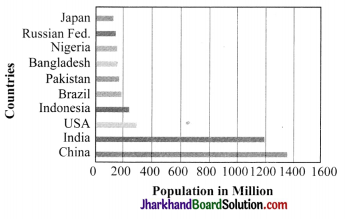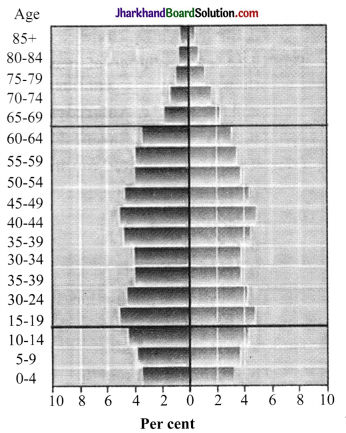JAC Board Class 8th Social Science Solutions Geography Chapter 6 Human Resource
JAC Class 8th Geography Human Resource InText Questions and Answers
Page 63
Question 1.
Study Fig. 6.1 and find out of the world’s total population which continent has: Of every 100 people in the world…

(a) only 5 per cent
(b) only 13 per cent
(c) only 1 per cent
(d) only 12 per cent
Answer:
(a) North America
(b) Africa
(c) Ocenia (Australia, New Zealand, Pacific islands)
(d) Europe
Page 64
Question 2.
Look at Fig 6.2 and find out: of these countries how many are in Asia? Colour them on a world map.

Answer:
There are 7 countries in Asia Japan, Russia, Bangladesh, Pakistan, Indonesia, India and China. On a world map, students need to colour on their own.
Page 67
Question 3.
Every human being is potential resource for the society. What will be your contribution as a human resource?
Answer:
Students need to do it on their own.
JAC Class 8th Geography Human Resource Textbook Questions and Answers
Question 2.
(i) Which does the term population distribution refer to?
(a) How population in a specified area changes over time.
(b) The number of people who die in relation to the number of people born in a specified area.
(c) The way in which people are spread across a given area.
Answer:
(c) The way in which people are spread across a given area.
(ii) Which are three main factors that cause population change?
(a) Births, deaths and marriage
(b) Births, deaths and migration
(c) Births, deaths and life expectancy
Answer:
(b) Births, deaths and migration
(iii) In 1999, the world population reached
(a) 1 billion
(b) 3 billion
(c) 6 billion
Answer:
(c) 6 billion
(iv) What is a population pyramid?
(a) A graphical presentation of the age, sex composition of a population.
(b) When the population density of an area is so high that people live in tali buildings.
(c) Pattern of population distribution in large urban areas.
Answer:
(a) A graphical presentation of the age, sex composition of a population.
Question 3.
Complete the sentences below using some of the following words:
sparsely, favourable, fallow, artificial, fertile, natural, extreme, densely When people are attracted to an area it becomes populated Factors that influence this include climate; good supplies of resources and land.
Answer:
When people are attracted to an area it becomes ..densely., populated Factors that influence this include ..favourable., climate; good supplies of …natural… resources and …fertile… land.
Question 4.
Activity
Discuss the characteristics of a society with ‘too many under 15s’ and one with ‘too few under 15s’.
Hint:
need for schools; pension schemes, teachers, toys, wheel chairs, labour supply, hospitals.
Answer:
Students need to do it on their own.
JAC Class 8th Geography Human Resource Important Questions and Answer
Multiple Choice Questions
Question 1.
When was the Ministry of Human Resources Development created to help the people of India to be healthy, educated and happy?
(a) 1990
(b) 1980
(c) 1995
(d) 1985
Answer:
(d) 1985
Question 2.
More than 90 per cent of world’s population lives on about per cent of the land surface.
(a) 30
(b) 20
(c) 10
(d) 40
Answer:
(c) 10
Question 3.
Population……..is the number of people living in a unit area of the earth’s surface. India has 382 people per square per kilometer whereas the world’s average is 14 only.
(a) density
(b) pyramid
(c) distribution
(d) number
Answer:
(a) density
Question 4.
The difference between emigrant and immigrant is:
(a) An emigrant is a person leaving her home country and an immigrant is a person leaving his home country.
(b) An emigrant is a person leaving her home country and an immigrant is a person entering a new country.
(c) An immigrant is a person leaving her home country and an emigrant is a person entering a new country.
(d) None of these
Answer:
(b) An emigrant is a person leaving her home country and an immigrant is a person entering a new country.
Question 5.
The main factors that brings a population change of an area are
(a) births, deaths, migration.
(b) births, deaths, style.
(c) births, deaths, religion.
(d) births, deaths, climate.
Answer:
(a) births, deaths, migration.
Question 6.
The least number of people live in the………continent.
(a) Africa
(b) Asia
(c) Antarctica
(d) Europe
Answer:
(c) Antarctica
Question 7.
The most populated continent is …….
(a) North America
(c) South America
(b) Asia
(d) None of these
Answer:
(b) Asia
Question 8. According to population, India’s rank in the world is…….
(a) first
(b) second
(c) third
(d) fourth
(d) none of these
Answer:
(b) second
Question 9.
Human resources differ from one another in respect of………
(a) education level
(b) sex
(c) age
(d) all of these
Answer:
(d) all of these
Question 10.
The method and way in which people are spread across the surface of the earth is called as the pattern of population.
(a) distribution
(b) density
(c) pyramid
(d) none of these
Answer:
(a) distribution
Very Short Answer Type Questions
Question 1.
What do you mean by birth rate and death rate?
Answer:
The number of live births per 1000 persons is known as birth rate. The number of deaths per 1000 persons is known as death rate.
Question 2.
Which country has experienced a loss in population due to emigration?
Answer:
Sudan is the country which has experienced a loss in population due to emigration.
Question 3.
What is the percentage of the world’s population who lives in about 10% of the land surface?
Answer:
The world’s population who lives in about 10% of the land surface is 90 per cent.
Question 4.
Why is population growth slowing in United Kingdom?
Answer:
In United Kingdom, population growth is slowing because of both low birth and death rates.
Question 5.
What do you mean by life expectancy?
Answer:
The number of years that an average person can expect to live is known as the life expectancy.
Question 6.
What is called as the pattern of population distribution?
Answer:
The way in which people are spread across the earth surface is called the pattern of population distribution.
Question 7.
What do you understand by population density?
Answer:
By population density we understand that it is the number of people living in a unit area of the earth’s surface. It is normally expressed as per square km.
Question 8.
People migrate from rural areas to urban areas. Why?
Answer:
Within countries large number of people may move from the rural areas to urban areas in search of better employment, education and health facilities.
Question 9.
Who are immigrants?
Answer:
Immigrants are those people who arrive in a country.
Question 10.
Who are emigrants?
Answer:
Emigrants are those people who leave a country.
Short Answer Type Questions
Question 1:
Distinguish between productive and dependent population.
Answer:
| Productive Population | Dependent Population |
| Population engaged in productive economic activities. | Population is dependent on productive population and not engaged in any economic activities. |
| 15-59 years of age group belongs to this category. | Below 15 years and above 60 years belongs to this group. |
| People are economically independent. | People are economically dependent. |
Question 2.
What is the general movement of international migrations? Why it happens?
Answer:
The general movement of international migrations is from the less developed nations to the more developed nations in search of better employment opportunities and better living standards.
Question 3.
When was Pradhan Mantri Kaushal Vikas Yojna (PKVY) started? What was the objective of this scheme?
Answer:
Pradhan Mantri Kaushal Vikas Yojna (PKVY) was started in 2015. Its aim was to train one crore Indian youth from 2016 to 2020. The objective of this scheme is to encourage towards employable skills by giving quality training to probable and existing wage earners.
Question 4.
What does the shape of a population pyramid of Japan point out? Answer: In countries like Japan, low birth rates make the pyramid narrow at the base. Decreased death rates allow numbers of people to reach old age.

Answer:
Population Pyramid of Japan – The base of the pyramid is narrow. This indicates less birth rate when compared to the death rate. Since the birth rate is less, the number of children who grow into adults will also be considerably less. So, the overall population is also less.
Question 5.
Why some countries such as Kenya have high population growth rate?
Answer:
Some countries such as Kenya had high population growth rate because they have both high birth and death rates. Nowadays, with improved health care, the death rates have fallen but birth rates still remain high which leads to high growth rate.
Question 6.
What has caused the population explosion?
Answer:
In 1804, the world’s population reache(d) one billion. A hundred and fifty years later, in 1959 the world’s population reached 3 billion and it is often known as population explosion. Less than 40 years later, in 1999, the population doubled to 6 billion. The main reason for this growth was that with better food supplies and medicine, numbers of deaths were fallen down, while the number of births still remained fairly high.
Question 7.
Do you think climate affect the population distribution of an area? If yes, then how?
Answer:
Yes, I think climate affects the population distribution of an area. People usually avoid extreme climates that are very hot or very cold like Sahara desert, polar regions of Russia, Canada and Antarctica.
Question 8.
In brief write about the distribution of population.
Answer:
Distribution of population:
- More than 90 per cent of the world’s population lives in about 10 per cent of the land surface.
- The distribution of population in the world is extremely uneven. Some areas are very crowded and some are sparsely populated.
- Very few people live in high latitude areas, tropical deserts, high mountains and areas of equatorial forests. Many more people live north of the Equator than south of the Equator.
- Almost three-quarters of the world’s people live in two continents Asia and Africa.
Question 9.
Why do you think population study essential for the government?
Answer:
Population study is essential for the government because it helps to plan for the areas such as education, housing, social security, education, employment and environmental preservation and conservation.
Long Answer Type Questions
Question 1.
Explain briefly the Ministry of Human Resources Development in India.
Answer:
The Ministry of Human Resources Development in India is an Indian government ministry which is responsible for the development of human resources. It has been divided into departments:
- The Department of School Education and Literacy: it deals with primary education and literacy.
- The Department of Higher Education: it deals with secondary and post-secondary education.
In 1910, under the British rule, the department originated as the Indian Education Department. After independence, the Ministry of Education was created in 1947. The Ministry of Education was merged with the newly created Ministry of Human Resources Development in 1985. The Ministry’s objective is to achieve universal access and enrollment, universal retention of children upto 14 years of age in school and essential and fundamental improvement in the quality of education to enable all children to achieve substantial levels of learning. Also paying special attention to disadvantaged groups such as the poor, females and the minorities.